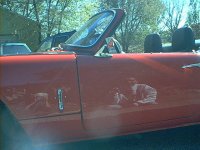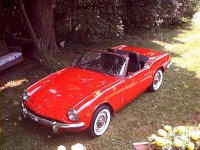It’s easy to talk about removing sanding scratch in terms of “grit” but the problem is that the numbers don’t tell the whole story. Besides the variation in different paints’ sensitivity to scratching there are
huge variations in abrasives and techniques.
Gloss comes from smoothness. When removing defects like sanding scratch, the goal is always the same, to abrade the surface until the entire area is smooth and level. To level a surface you need to cut it down to the bottom of the
deepest defect. That’s the critical part. It doesn’t matter how shallow or fine most of the scratches, or the average scratch are. You need to work to the deepest to achieve high gloss.
It’s common to assume that sandpaper is sandpaper is sandpaper. It’s not. Sandpapers are graded more or less by their
average grit. Two papers can have the exact same numerical grade but leave very different scratch patterns. If one product has a slightly higher percentage of larger particles than another but averages the same, it can be graded the same but will leave deeper scratches that are harder to buff out.
Abrasives like Meguiar’s Unigrit, Mirka Abralon and 3M Trizact (not 3M’s standard papers!) have far more uniform grit structures and leave much more uniform scratches that buff out cleaner and easier.
And the exact same piece of paper on the exact same piece of paint will leave completely different scratches if you use it with a foam sanding block, rubber sanding block or just your hand. Your hand will leave the worst, hardest to remove scratches because it’s impossible to apply uniform pressure with your fingers or palms.
Even with very high quality finishing abrasives, 1500 grit is fairly coarse, especially on clearcoats. The finer you sand, the easier, faster and cleaner it is to buff out. Abrasive manufacturers recommend going finer for highest quality finishing. 2000 and 2500 are common but 3000 and 4000 aren’t unreasonable. Most body shops stop at 1500, but their practices are based on maximum throughput and minimum cost, not high quality. (And an awful lot of them do truly miserable work.)
While 3M says Perfect-It II can be used for 1500 scratch, it’s meant to be used with a
rotary buffer. If a machine can work a hundred times faster than you can, they can make the chemicals twenty five times less aggressive and still get twice as much work done in half the time. Use that chemical by hand and you’re looking at twenty five times more work. (It’s actually more complicated than that but you get the idea.)
Rotary buffers are powerful tools and I wouldn’t recommend anybody use one without training and practice. But that’s what the industry uses after sanding and for correcting deep defect so that’s what all of the professional chemical product lines are optimized around. There are fine grade products that can be use with orbital machines and by hand but they aren’t formulated for deeper defects.
Professional grade orbital machines like the Porter-Cable, Makita or Festool can remove significant defects (oxidation, swirl marks, water spots, ...) but they aren’t up to large areas of sanding scratch. On small areas that have been sanded with very fine abrasives using good sanding techniques they may be adequate, especially with small diameter pads that let you concentrate the applied work.
Consumer level orbital machines almost always lack the power or speed to remove any but the lightest defects.
If you’re going to continue by hand you’ll probably want to step to a finer paper (at least 2500, using finishing specific abrasives as I mentioned before) with a foam sanding block, keeping your sanding area as small as possible and be prepared for lots of work polishing it out.
tomshobby said:
Find a used car dealer and have them buff it for you. They will have everything plus the experience. ...
RedTR3 said:
...Like Tomshobby stated, a good auto detail shop can do the job for you for not much cost.
I will agree with finding a good detailer. A detailer who knows what he’s doing will make quick work of it and produce excellent results. (The trick is to find a
good one. They aren't exactly common.)
I disagree with the used car dealer. A detailer who does excellent work makes his customers happy. A dealer prep guy who does good work makes his boss mad for taking too much time.
Dealers give dirty work, like buffing, to the least experienced, lowest paid guy on the lot. Their job is to get it out the door fast and cheap. Their favorite trick is to swirl the snot out of a finish, slap on a high filler glaze and call it done. The car will look fairly shiny on the lot, for a little while, but the first time you wash it the swirls all come back.
The professional detailers I know spend a large percentage of their time fixing dealer work.
PC.
.

 Hi Guest!
Hi Guest!

 smilie in place of the real @
smilie in place of the real @
 Pretty Please - add it to our Events forum(s) and add to the calendar! >>
Pretty Please - add it to our Events forum(s) and add to the calendar! >> 



